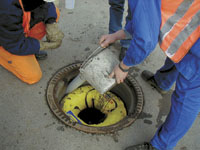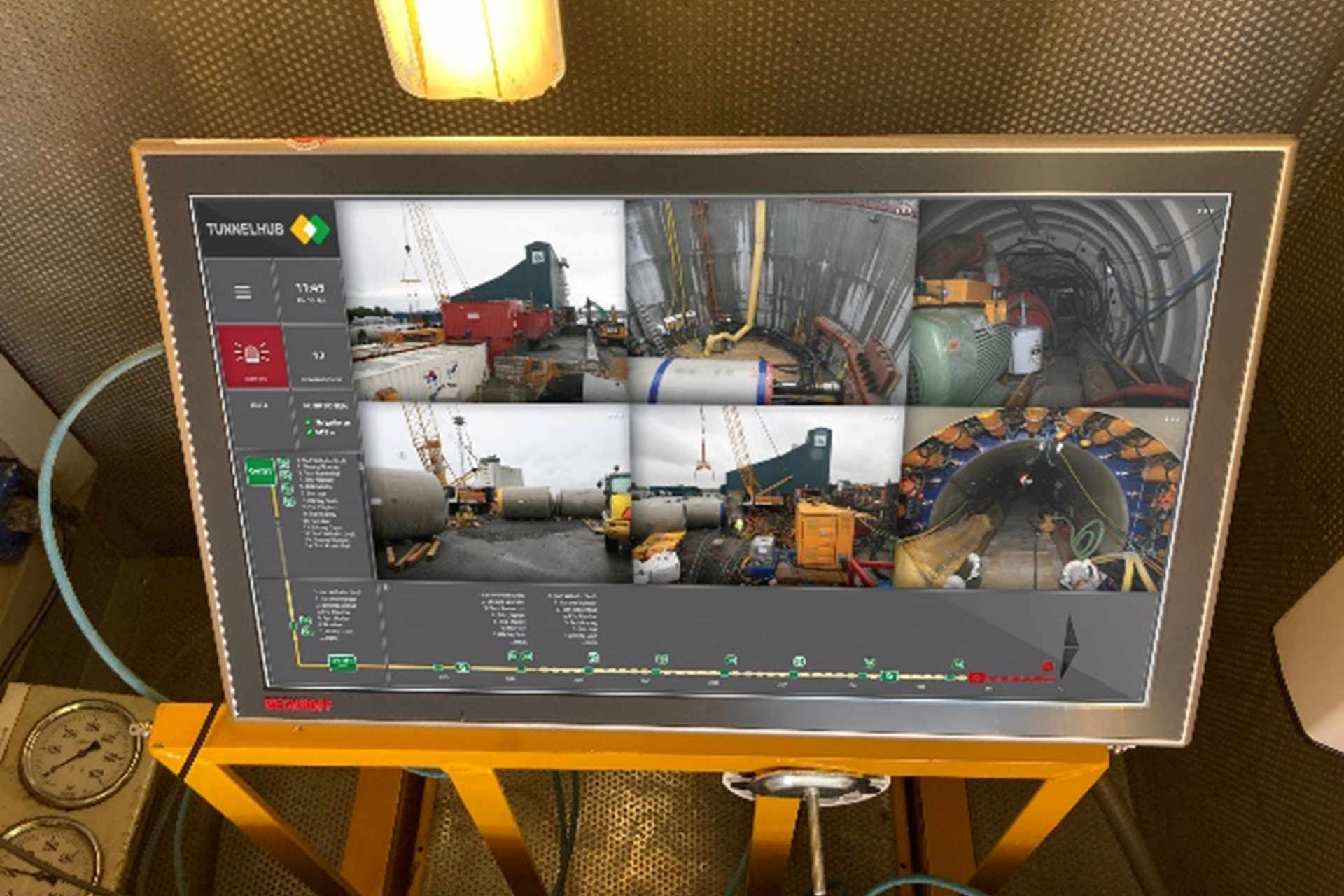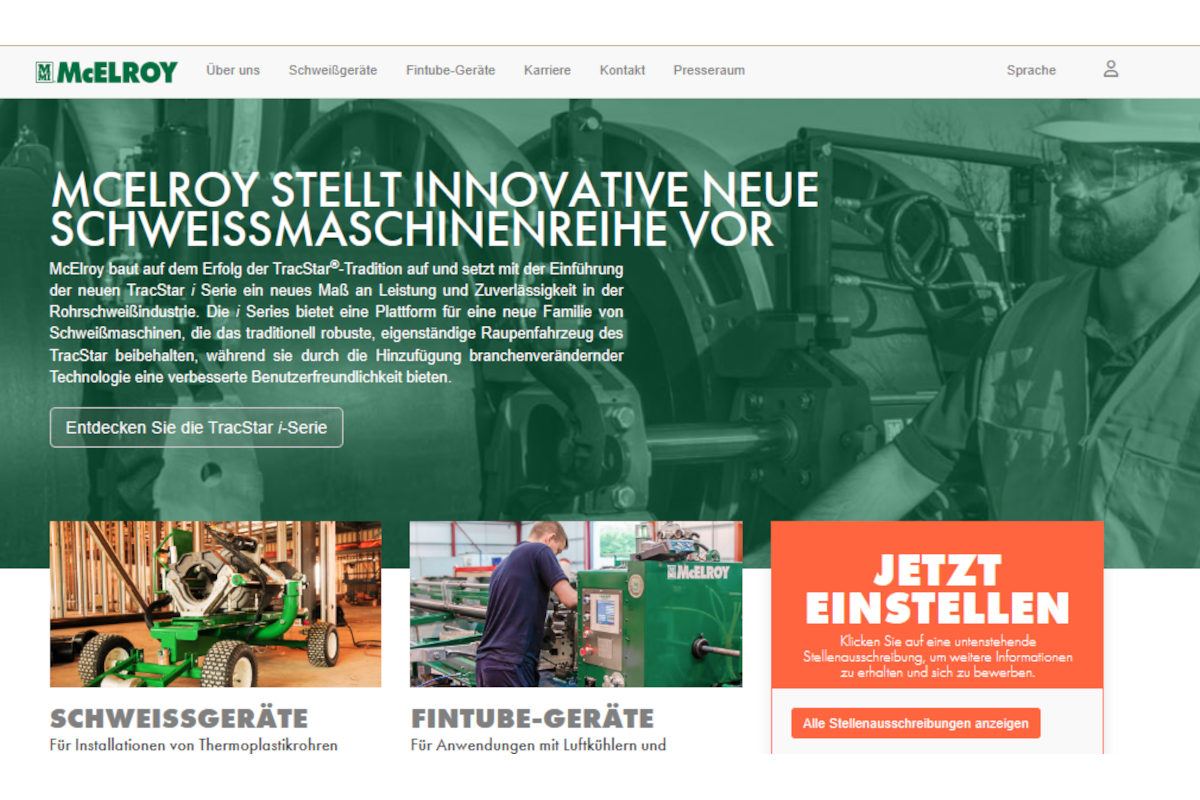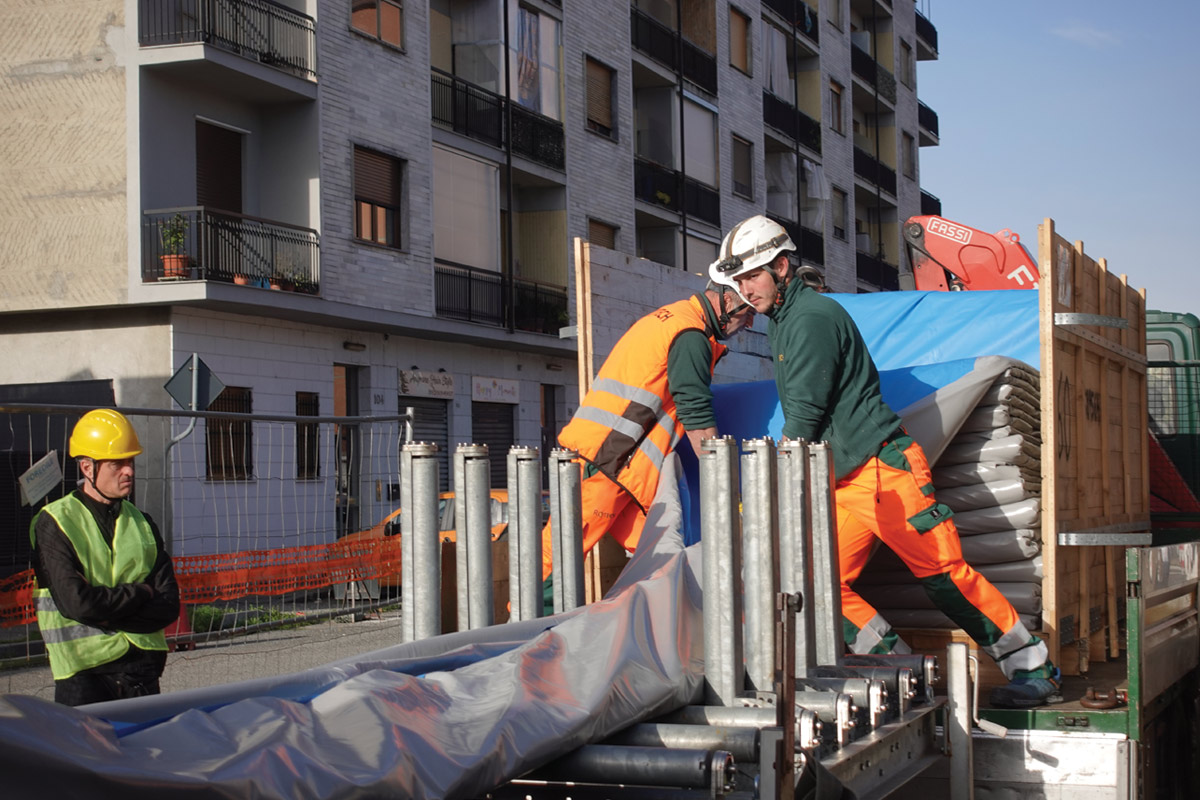Manhole Frame Regulation- The Technique Has Come of Age
 Until 25 years ago, technical knowledge in Germany was such that installingmanhole frames or regulating frames, that have dropped, slipped or tilted, meantbedding them on a layer of concrete. This manual technique was quite expensiveand the three-day curing time for the mortar was extremely inconvenient; itregularly led to detours or bottlenecks that impeded traffic flow. The need formanhole frame regulation has always been due to chemical processes (road salt)and the steadily increasing volume of traffic, especially of heavy goodsvehicles.
Until 25 years ago, technical knowledge in Germany was such that installingmanhole frames or regulating frames, that have dropped, slipped or tilted, meantbedding them on a layer of concrete. This manual technique was quite expensiveand the three-day curing time for the mortar was extremely inconvenient; itregularly led to detours or bottlenecks that impeded traffic flow. The need formanhole frame regulation has always been due to chemical processes (road salt)and the steadily increasing volume of traffic, especially of heavy goodsvehicles.
The Basic Essential
The impetus forinnovations in the area of manhole frame regulation was the escalating cost ofconventional frame lifting, which relied on expensive, but error-prone manuallabor. Another reason was the inexorable increase in traffic that exacerbatedthe problem of delays caused by the roadwork. The challenge was twofold: Reducecosts by improving and rationalizing techniques, while at the same timeminimizing disruption to traffic flow.
The development of dry mortars quickly pointed the way to numerousapplications for modified cementitious materials in sewage installations andpipe work.
The German firm of ERGELIT GmbH marketed its Superfix grout as early as 1981.This mortar guaranteed easy handling and could be used in a wide variety offluctuations in temperature and atmospheric humidity. Great strides were thusmade in reducing possible failures. Furthermore, this product provided thenecessary bond between the manhole frame and the top of the shaft. The ease ofapplication and the small amount of labor required meant significant savings. Afast setting time also led to reduced costs.
Whereas conventional frame regulation methods allowed traffic to flow after24 hours at the earliest, this grout meant traffic was free to flow after justone hour. In addition, this mortar’s resistance to frost and road salt was animportant factor in the development of new techniques for frame regulation.
The new type of regulation has been continuously improved. To support bothclients and suppliers, HERMES Technologie created a quality assurance handbookin 2000, and offers contracting firms an extended product guarantee, once theyhave gained HERMES Technologie certification.
Machinery & Equipment
The frameregulation market has access to a range of ideal products, now that grouts havebeen developed and become more and more sophisticated and specialized over theyears. In the course of time, the process was further rationalized with thedevelopment of specialized machinery and equipment.
• Formwork: The new grout, which achieved the desired bond thanks to its highflow-rate, could not be applied using conventional shuttering. Special types oftubular collar were developed for directing the grout into the repair jointbetween the lower edge of the raised frame and the top of the shaft. It iscustomary nowadays to use ribbed plugs for round sewer shafts. Formers were alsoproduced in various materials (rubber, lead) for inserting in lateralconnections and for rectangular shafts.
• Frame Lifters: Naturally, even 25 years ago manhole frames were not justloosened and raised with a pneumatic hammer and a pickax. But it was with thedevelopment of the shaft renovation process that the development of framelifting apparatus was able to make crucial progress. Mechanical frame lifterswith a lifting capacity of more than 20 m tons are also in use, as are hydrauliclifters, both manually operated and motorized, with hoisting capacities of up to50 m tons and with different diameters.
• Shaft Debris Collectors: While the frame is being raised or while the gapto be filled under the frame is being prepared, loose material or old pieces ofgrouting can quickly be caught on grouting sheets. These collectors are easy toinstall underneath the area of repair (a one-man operation), and they preventmaterial falling down into the shaft. As far as this operation is concerned, thetedious and dangerous practice of climbing down shafts is a thing of thepast.
• Height Adjusters: Frames that have subsided are raised to approximately theoriginal level by means of a manhole frame lifting apparatus. There are variousaids to determining the exact level. A tried and tested solution is thethree-point frame-lifter equipped with three 35-cm arms and an adjustment rangeof –5 mm to +55 mm. Leveling is quicker and more precise. In the case of bothnew build and frame replacement, this apparatus means you can avoid theincorrect and inaccurate practice of packing stones — or even worse, woodenwedges — under the frame. The height adjuster allows the injection of high earlystrength grout into the whole of the gap between the frame and the top of theshaft, in one smooth operation.
• Manhole Cover Lifters: Lifting and shifting sewer shaft covers in situ withinadequate tools such as pickaxes or crowbars present direct and indirectdangers (injuries to feet, legs and the back). The development of the Titan-ALUmanhole cover lifter has removed such dangers. This universal lever, made oftitanium-aluminium with an extremely high bending strength, is extremelyadaptable and can cope with freeing, lifting and swinging both round andrectangular covers another technique for lifting manhole covers and transportingthem short distances is provided by the Universal manhole cover lifter UDH-60.The UDH-60, with its operator-controlled automatic claws, is mounted on atwo-wheeled axle. This makes it easy to roll the cover away from the immediaterepair area. Further developments, such as the all-purpose cover lifter DH 18for particularly heavy manhole covers, complete the range of shaft renovationtools.
• Manhole Top Cutting Machines: Manhole frame cutting machines were developedfor cutting out manhole tops in asphalt or concrete, cleanly and economically.They are particularly useful for raising flanged frames, especially where a newcarrier layer is being laid. Cutters such as the petrol-powered DS 1400 aredesigned for shafts with a diameter of 60 to 140 cm and have a variable cuttingdepth of up to 15 cm. These machines are easily transported around the site, andare particularly appropriate for larger scale operations. In 2005, a new methodfor cutting precise circular holes arrived on the specialist market in the formof the RKS 20T. This light, user-friendly machine is equipped with an electricmotor. It produces circular cuts from 80 to 150 cm Ø. Depending on which motoris fitted (1,300 watt/2,500 watt), the RKS 20T’s concave blade has a cuttingdepth in asphalt of between 25 and 40 mm. The clean cut produced neatlyseparates the repair area from the surrounding asphalt. This clean-cut edge isvital when it comes to inserting bitumen tape. The hydraulically powered Stehrmilling cutter achieves a similar result. It is connected as an attachment to awheeled trolley.
• Edge Work Materials: The full manhole frame regulation process requires arange of more materials. It should be mentioned here about VBT damping rings,commonly known as anti-rattle rings. A noteworthy new development in this areahas been the anti-rattle filler. This malleable compound of two environmentallyneutral synthetic components is inserted into the manhole cover support orinto the frame itself in the form of a bead of self-hardening paste as a dampinglayer. This compound is a versatile, high-quality alternative to sound-damping,and is unaffected by the diameter or size of the manhole frame. Specialmaterials also exist for repairing crumbling or cracked edges around the frame.For this work — depending on the extent of the loss of surface material — thereare bituminous tape, masking tape and shaft sealing strips. Supplementaryproducts MSK liquid asphalt or MSK “cold” Rephalt have proven themselves in therepair of damage to asphalt edges. In their physical properties, they are inevery way equal to the surrounding hot asphalt.
The Future
Manhole frame regulation is asafety concern for highway authorities and is an ongoing source of business forroad repairers. Firms constantly offer innovations, but these are not alwaystaken up because of the financial pressure that has arisen from the undeniablytight budgets of highways authorities. Even more striking, since it has aneffect on the general economy, is a certain unjustifiable tendency observable inthe public sector to award contracts only to the lowest tender. The quality ofinnovative yet proven processes that give a more cost-effective repair in thelong run are usually ignored.
Suppliers frequently try to respond with prices that don’t cover their costs.Sometimes they try to bring in new, but not better, processes. Tried and testedprocesses and high-quality know how that have been developed over a long periodsuddenly become unattractive, thanks to a dubious tendering system and couldlose out to the competition — perhaps even disappear from the marketaltogether.
It is not just in this segment of the market that the situation outlined hereputs a brake on inventiveness. It is a common problem, because this search forcheapness, which is economically unjustifiable, is spreading across the whole ofthe demand side. It distorts competition, blocks technological advance and leadsto a supply-side decline and consequent loss of jobs.




